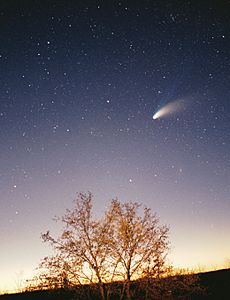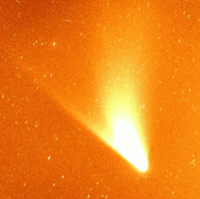Comet Hale–Bopp facts for kids
| Discovery | |
|---|---|
| Discovered by | Alan Hale Thomas Bopp |
| Discovery date | July 23, 1995 |
| Designations | |
| The Great Comet of 1997, C/1995 O1 |
|
| Orbital characteristics | |
| Epoch | 2450460.5 |
| Aphelion | 370.8 AU |
| Perihelion | 0.914 AU |
| Semi-major axis | 186 AU |
| Eccentricity | 0.995086 |
| Orbital period | 2520–2533 yr (Barycentric 2391 yr) |
| Inclination | 89.4° |
| Last perihelion | April 1, 1997 |
| Next perihelion | 4385 ± 2.0 AD |
| Physical characteristics | |
| Dimensions | 40–80 km |
| 0.01–0.07 | |
Comet Hale–Bopp (also known as C/1995 O1) was a very famous comet. It was probably the most watched comet of the 20th century. It was also one of the brightest comets seen in many decades.
Hale–Bopp was found on July 23, 1995. Two people, Alan Hale and Thomas Bopp, discovered it separately. They found it before it became bright enough to see without a telescope. Scientists thought it would be very bright, and they were right! It reached its brightest point around April 1, 1997. The comet was visible to the naked eye for a record 18 months. This was twice as long as the previous record holder, the Great Comet of 1811. Because of this, Hale–Bopp was called the Great Comet of 1997.
Contents
How Comet Hale–Bopp Was Discovered
The comet was found by two different people on July 23, 1995. These two people were Alan Hale and Thomas Bopp. Both of them lived in the United States.
Alan Hale had spent many hours looking for comets. He was watching known comets from his home in New Mexico. Just after midnight, he saw Hale–Bopp by chance. He saw that the object was moving against the background stars. He then sent an email to the Central Bureau for Astronomical Telegrams. This group checks new discoveries in space.
Thomas Bopp did not own a telescope. He was with friends near Stanfield, Arizona. They were looking at star clusters and galaxies. He happened to see the comet through his friend's telescope. He realized it might be something new. He checked his star maps, just like Hale did. He found that no other known objects were in that area. The next morning, it was confirmed that it was a new comet.
Comet Hale–Bopp's Closest Approach to the Sun
Hale–Bopp became visible without a telescope in May 1996. Its brightness grew slower later that year. But scientists were still hopeful it would get very bright. It was too close to the Sun to be seen in December 1996. When it came back into view in January 1997, it was already bright. Anyone could see it, even from big cities with light-polluted skies.
The Internet was becoming very popular at that time. Many websites tracked the comet's journey. They shared daily pictures from all over the world. These sites became very popular. The Internet helped many people become interested in Comet Hale–Bopp.
As the comet moved closer to the Sun, it got even brighter. It grew two tails. The blue gas tail pointed straight away from the Sun. The yellowish dust tail curved along its path.
When it passed its closest point to the Sun on April 1, 1997, it was amazing to see. It shone brighter than any star in the sky except Sirius. Its dust tail stretched about 40–45 degrees across the sky. The comet was visible before the sky got fully dark each night. Many great comets are very close to the Sun when they pass by. But Comet Hale–Bopp was visible all night for people in the northern hemisphere.
The last time people saw it without a telescope was in December 1997. This means the comet was visible for 569 days. That is about 18 and a half months. The old record was held by the Great Comet of 1811. That comet was visible for about 9 months.
What Scientists Discovered
Chemicals Found
Scientists found many organic chemicals in Hale-Bopp. They had never seen some of these chemicals in a comet before. It was also the first comet found to have the gas argon in it.
The comet also had a special sodium tail. This tail stretched for about 50 million kilometers. You can see a picture of it on the left.
Water on Earth
Scientists studied the amount of deuterium in Hale–Bopp's water. Deuterium is a type of hydrogen. They found that the amount of "heavy water" (water with deuterium) in Hale–Bopp was about twice that of Earth's oceans.
This discovery is important for understanding where Earth's water came from. It suggests that comets like Hale–Bopp might have brought some water to Earth. But because of the difference in deuterium, they probably were not the only source of water on our planet.
Comet Hale–Bopp's Impact

Hale–Bopp was visible for a long time. It was also widely covered in the news. This means it was likely the most-watched comet in history. It had a much bigger impact on the public than the return of Halley's Comet in 1986. More people saw Hale–Bopp than any of Halley's past visits. For example, 69% of Americans had seen Hale–Bopp by April 9, 1997.
Hale–Bopp broke several records. It was the farthest comet from the Sun found by amateur astronomers. It had the largest known comet center (nucleus) after 95P/Chiron. And it was visible without a telescope for twice as long as the previous record holder. It was also brighter than a certain level (magnitude 0) for eight weeks. This was longer than any other recorded comet.
Images for kids
See also
 In Spanish: Cometa Hale-Bopp para niños
In Spanish: Cometa Hale-Bopp para niños




